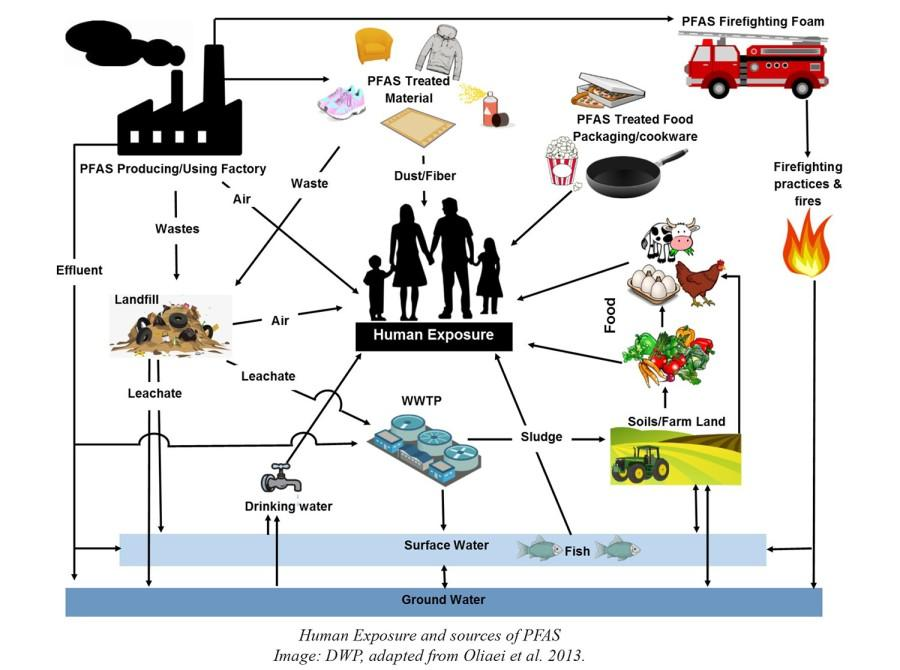A community guide to address forever chemicals pollution

By Huda Alkaff
January/February 2023
What can you do when you learn that your drinking water is contaminated with a toxic substance? I asked myself this question when my city, West Bend, Wisc., issued a press release in June 2022 that at least one groundwater well, the source of drinking water for many residents, had been shut down because of PFAS (per-and poly-fluoroalkyl substances) contamination. In the past, the other two wells that are now the drinking water’s main source have also had elevated PFAS levels. So how can we ensure that our water is safe to drink? This is something I’m still trying to answer.
What is PFAS?
Fluorinated chemicals known as PFAS are a class of about 9,000 man-made toxic chemicals used in a vast number of water-, heat- and stain-resistant products. Having been around since the 1940s, they are also known as “forever chemicals” because they stick around in our bodies and the environment. We are talking about this now in part because DuPont, 3M and other chemical manufacturers have covered up evidence of PFAS’ negative impacts since the 1960s.
PFAS can last for years in our bodies, leading to a dangerous build up over time. Some of the most studied ones, such as PFOA (per-fluoro-octanoic acid) and PFOS (per-fluoro-octane-sulfonic acid), do not degrade naturally in the environment. Even wastewater treatment plants cannot break them down. This probably doesn’t come as a surprise to some people, given that PFAS are a group of chemicals used to make fluoropolymer coatings and products that resist heat, oil, stains, grease and water.
Experts are still learning about how bad PFAS are for us. So far, studies show that at high enough levels, some PFAS chemicals have serious health effects, including decreased fertility, hormonal changes, increased cholesterol, weakened immune system response, increased cancer risk, higher risk for high blood pressure and growth and learning delays in infants and children.
If you are wondering how to avoid PFAS chemicals, the answer is simple: you cannot.
PFAS are found everywhere from cosmetics to outdoor gear, non-stick pans, food wrappers, sunscreen, shampoo, electronics, wires, cables, computer chips, dental floss and countless other everyday items. They’re also present in the firefighting foam used on military bases and commercial airports.
As a result, over 95% of U.S. residents have PFAS in their bodies. Drinking water is one of the most common ways we get exposed to them. In fact, PFAS has been found in the tap water of at least 16 million people in 33 states — including in the drinking water supplies of major cities like New York, Washington, D.C. and Chicago — as well as in the groundwater in at least 38 states. In fact, PFAS are found in rainwater worldwide.
What’s Happening at the National Level?
The U.S. government is increasingly looking at ways to address PFAS at the state and federal levels. However, after decades of widespread exposure, these measures are still too little too late.
In the early 2000s, regulators divided PFAS into two groups: long-chain compounds (1st generation PFAS like PFOA and PFOS) to be phased out by manufacturers by 2015, and a new generation of short-chain PFAS (e.g., GenX, PFBS and PFHxA) used as replacements. Chemical manufacturers claim that the latter are safer because they tend to leave our bodies quicker. However, early studies suggest they might be just as bad as long-chain PFAS.
Most recently, the U.S. Environmental Protection Agency (EPA) took a bold step forward by dropping the interim “safe” threshold for PFOA and PFOS from 70 ppt (parts per trillion) and 20 ppt to 4 ppq (parts per quadrillion) and 2 ppq respectively, which is essentially zero. While this new threshold, technically established through a drinking water advisory, is voluntary, the EPA encourages the utilities to test for both of them periodically and inform consumers of any detectable levels.
Testing for PFAS is crucial, because it allows both residents and agencies to know the levels of PFAS pollution and exposure, which then informs the measures that will be taken. The Bipartisan Infrastructure Law passed in 2021 provides $10 billion in funding to address PFAS: $5 billion to help small and disadvantaged communities, $4 billion to help drinking water utilities remove PFAS from water supplies or connect well owners to local water systems, along with $1 billion to help wastewater utilities address PFAS in wastewater discharges.
Several agencies are actively addressing PFAS around the country. The Biden administration’s PFAS Action Plan, launched in early 2022, aims to prevent and clean up pollution while speeding up research to better understand the problem and inform consumer protection efforts. Congress introduced bills declaring PFAS as contaminants eligible for cleanup funds (under the Superfund law) and providing the U.S. Geological Survey with funding to develop new ways to detect PFAS and conduct testing.
Although these efforts are going in the right direction, the best way to keep PFAS out of our soil and water (and our bodies!) is to stop using them. Unfortunately, the federal government is not currently considering a PFAS ban.
Averting exposure to dangerous chemicals like PFAS helps save hundreds of millions of dollars annually by eliminating the health care expenses, lost wages, work absences, decreased job productivity and treatment costs that the water utilities are required to spend to meet federal drinking water quality standards. Preventing and addressing toxic pollution in our waters is a major national priority to protect public health. Regulators and legislators must do much more to protect us.
What’s Happening in Wisconsin?
In addition to federal efforts, state governments are taking action to regulate PFAS. Wisconsin and other states have passed laws restricting the use of firefighting foam and banning state agencies from purchasing food containers with PFAS. Wisconsin and other states are pursuing litigation against PFAS manufacturers for contaminating water supplies.
An increasing number of Wisconsin communities are wrestling with PFAS in their water supply, among them Adams, Eau Claire, Marinette, Madison, Marshfield, Milwaukee, Wausau, West Bend, Peshtigo and Campbell. The worst contamination has been found in Marinette County around the Tyco Fire Products testing facility, which was used to test firefighting foam until 2017. PFAS have also been detected in wildlife across the state. The Wisconsin Department of Natural Resources (DNR) has issued advisories for fish in Peshtigo, Monroe County and Madison lakes, as well as in the Yahara River.
The DNR recently adopted a 70 ppt standard for drinking water and an 8 ppt standard for most surface waters that can support fish. These state standards are meant to limit the amount of PFAS that can be dumped into state waters and municipal water systems. To comply with this, water utilities will be required to test their drinking water for PFAS starting this fall. All of these actions are going in the right direction, but, like the federal government, Wisconsin has not yet implemented a PFAS ban.
Why is it Important to Act Now?
• Widespread PFAS use has created an irreversible toxic legacy of global contamination.
• PFAS are accumulating in our bodies and those of our children every day. This reality poses an immediate threat to human health through our drinking water and places a major burden on wildlife.
• PFAS disposal is an unnecessary toxic waste problem (with no solution in sight) because safer chemicals are available.
What can communities do? Be a PRO.
See PFAS in Your Water Supply? A Quick Guide for Wisconsin Communities at https://wisconsingreenmuslims.org/water/
Protect:
- Minimize use of stain-resistant fabrics and non-sticking cookware; beware of certain fast-food packaging and dental floss brands
- Prevention is better than cure. The most appropriate solution is to prevent PFAS from entering our bodies in the first place. Protect our drinking water from forever chemicals
Research:
- Check data from the EPA testing results or look at this map by the Environmental Working Group and Northeastern University to know if your water supply has PFAS
- Call your water utility or city administrator to ask about whether PFAS has been found in drinking water in your area
- Learn about PFAS in drinking water in your city, state and nationally
Organize:
- Create a list of water-concerned organizations, groups, and residents and reach out to them to learn about their work and identify shared interests
- Follow recommendations regarding filtering water (e.g., consider installing reverse-osmosis filters, which are the most effective at filtering PFAS out)
- Join a PFAS-free coalition or, if there is none, form one
- Talk and write about your experience / story with PFAS and demand a PFAS-free environment. This is what I am doing here today!
Huda Alkaff is founder and director, Wisconsin Green Muslims.
Tell us what you thought by joining our Facebook community. You can also send comments and story pitches to horizons@isna.net. Islamic Horizons does not publish unsolicited material.
